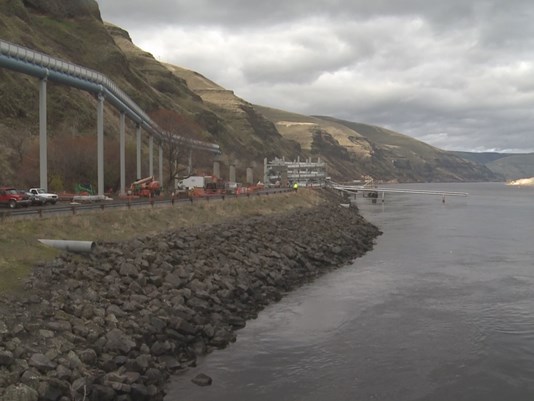forum
library
tutorial
contact

NOAA's Columbia Basin Partnership Task Force
Aims for Common Goals on Salmon/Steelhead Recovery
by Staff
Columbia Basin Bulletin, January 19, 2018
|
the film forum library tutorial contact |

|
NOAA's Columbia Basin Partnership Task Force
by Staff
|
 One of the many ongoing efforts regarding recovery of salmon and steelhead in the Columbia River basin is being undertaken by a group organized by NOAA Fisheries known as the Columbia Basin Partnership Task Force.
One of the many ongoing efforts regarding recovery of salmon and steelhead in the Columbia River basin is being undertaken by a group organized by NOAA Fisheries known as the Columbia Basin Partnership Task Force.
NOAA initially announced its intentions to form the CBP in October, 2015. By January, 2019 the task force is expected to make recommendations to the Marine Fisheries Advisory Committee on common goals for the long-term recovery of salmon and steelhead.
Those long-term goals, according to a Northwest Power and Conservation Council January 3 memorandum, are for salmon and steelhead listed under the federal Endangered Species Act as well as for fish that aren't listed.
The task force is expected soon to recommend a final shared vision for Columbia Basin salmon and steelhead, as well as qualitative and quantitative goals to meet conservation needs and provide harvest opportunities in the future, the memo says. These are now in draft form.
"Virtually any interest group in the Columbia River basin is involved and each member is obligated to speak for their organization," said Tony Grover, director of the Northwest Power and Conservation Council's Fish and Wildlife Division, during a Council Fish and Wildlife Committee meeting last week, Jan. 9.
The CBP follows on a collaborative regional effort to "survey, collect, identify, and refine a realistic set of quantitative objectives for program focal species, beginning with adult salmon and steelhead" that is included in the Council's 2014 Fish and Wildlife Program. Because the CBP Task Force has very similar goals using a similar process, the memo says, the Council on Feb. 3, 2015 merged its salmon and steelhead objectives process with NOAA's CBP Task Force process, Grover said.
"Since then we've been merged at the hip," he said.
The full task force first met in Portland Jan. 24 and 25, 2017. At that first meeting Barry Thom, regional administrator of NOAA Fisheries West Coast Region, told the assembled group that multiple, sometimes overlapping, recovery plans are present across the region and that the task force is a "new forum unlike anything that has come before."
The idea of the CBP actually took form out of NOAA's 2012 Columbia Basin Assessment, long before the Council's 2014 Fish and Wildlife Program. Thoms pointed out an absence of long-term integrated salmon recovery goals in the region, although there are many different plans for recovery, and that those plans are not all working in the same direction.
"Can we integrate these responsibilities and use the stakeholders in this room to plan that integration?" he questioned at that first meeting, asking the group of 35 to work together to "define our salmon future. Without goals and a common purpose, we will continue to spin our wheels."
(See CBB, January 27, 2017, "NOAA Kicks Off Columbia Basin Partnership Task Force: Can Salmon Recovery Efforts Be Integrated?")
Since that first meeting the CBP has made progress, Grover said.
A "hard fought" Draft Vision developed by the CBP says "A healthy Columbia River Basin where thriving salmon and steelhead are indicators of clean and abundant water, reliable and clean energy, a robust regional economy, and vibrant cultural and spiritual traditions, all existing in harmony with ecosystem benefits."
CBP members are also developing qualitative goals. Those include sustainability goals for avoiding extinction and for establishing rebuilding trends, as well as guidelines for how fisheries and hatcheries should be managed. Goals also include social, cultural and economic benchmarks.
Quantitative goals refer to setting numerical recovery goals for salmon and steelhead stocks, including chum and coho salmon, mid-Columbia River steelhead, upper Columbia River summer chinook and Snake River spring/summer chinook.
Some of those five stocks are listed and some are not, Grover said. "Some are in awful condition, like chum, and coho are an odd mix with listed fish below Hood River and those above not listed."
He said CBP subgroups are looking at the details of these fish and beginning to set near and long-term goals. "It's not surprising that the long-term goals are aspirational," he said. "The near and mid-term goals will require very specific actions."
Finally, the CBP is making a list of issues it intends to discuss as it continues to develop the long-term recovery goals. A draft set of issues is here.
Among the issues identified for further discussion are:
The Columbia Basin Partnership Task Force web page is at here.
Related Pages:
Salmon Recovery Assessment: Who Leads The Long-Term Way? A Re-Defined NW Power/Conservation Council? by Staff, Columbia Basin Bulletin 12/20/13
NOAA Launches 'Situation Assessment' Of Columbia River Basin Salmon, Steelhead Recovery by Staff, Columbia Basin Bulletin 12/14/12
Related Sites:
Feds Seeking Nominations For New Salmon/Steelhead 'Columbia Basin Partnership Task Force" by Staff, Columbia Basin Bulletin 7/22/16
NOAA Fisheries Forms 'Columbia Basin Partnership' To Provide Collaborative Forum On Salmon/Steelhead by Staff, Columbia Basin Bulletin 10/30/15
learn more on topics covered in the film
see the video
read the script
learn the songs
discussion forum
